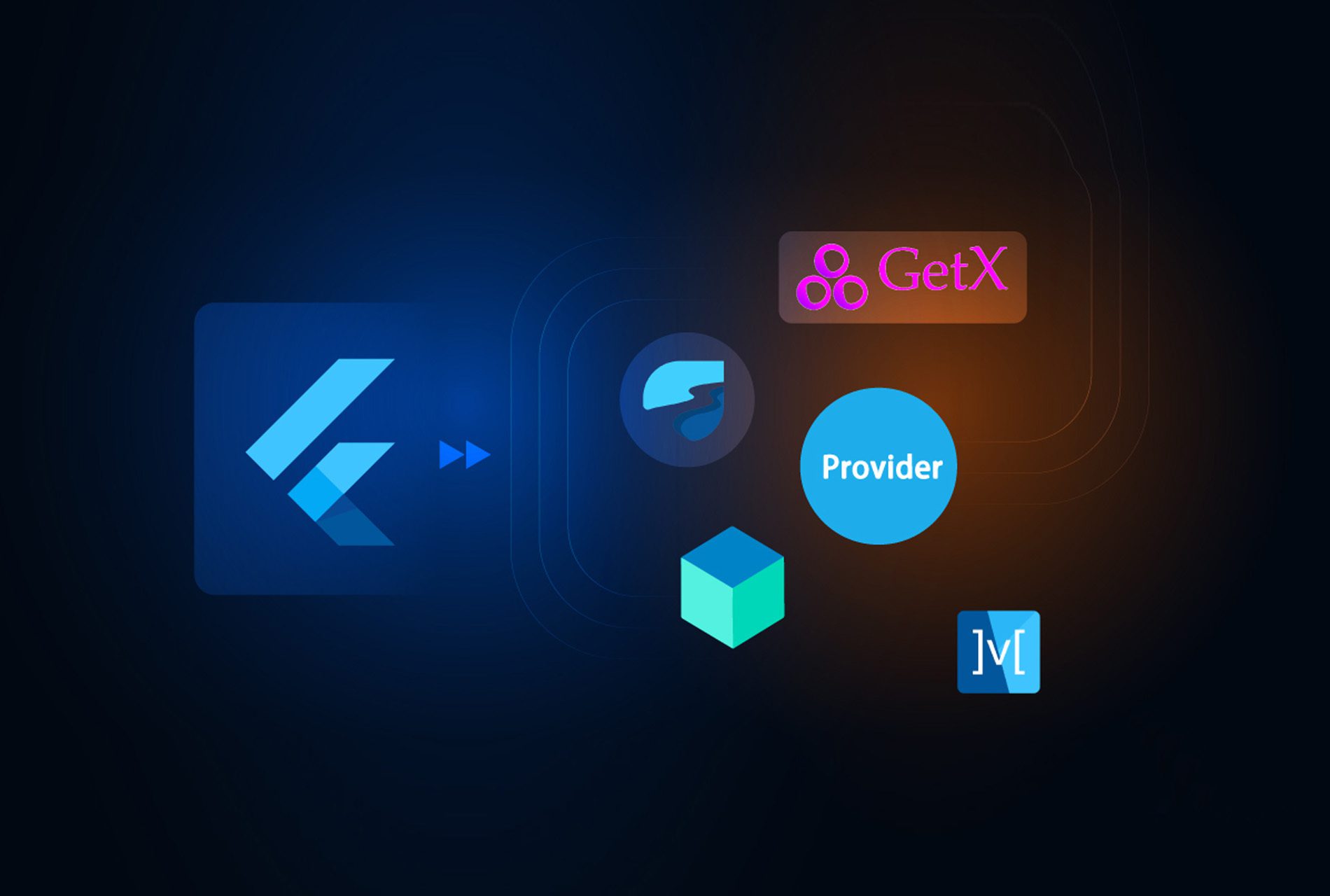Flutter has quickly become one of the most popular frameworks for building mobile apps. Its hot reload feature allows for quick iteration and development, and the unified codebase allows developers to build apps for both iOS and Android from a single codebase. Flutter State management libraries are extremely handy as they allow you to efficiently manage the app state in a structured and organized way.
Managing state across screens can become challenging as apps become more complex. In this blog, we’ll dive into Flutter’s top state management libraries in 2023 and explore their pros, cons, and how they work in depth.
What is Flutter State Management?
State management refers to managing data and UI state in your Flutter app. This includes user authentication, themes, locale, routing, shopping cart items, UI/form states, and more.
As an app grows in complexity and screens, keeping track of state and efficiently passing data between screens and widgets becomes much harder. Some common problems include:
- Duplicated state logic across screens
- Loss of state when switching screens
- Difficulty accessing state from deeper nested widgets
- Confusing data flows between UI and business logic
- Increased bugs due to state inconsistencies
Flutter State Management Libraries help solve these problems by providing mechanisms to store the state in a centralized location and update UI components when that state changes.
Some benefits of using a more robust state management library:
- Maintain a single source of truth for the app state
- Easily pass data between screens, widgets, and classes
- Update UI automatically when relevant state changes
- Logic stays separated from UI code for better organization
- Increased testability and modularity
- More predictable state changes
What are Flutter State Management Libraries?
State management libraries are third-party packages and frameworks that help manage data and UI state in Flutter Mobile App Development.
As apps grow, keeping track of state and passing data between screens can become difficult. State management libraries aim to solve these problems by providing tools and patterns to:
- Maintain a centralized, single source of truth for the app state
- Update UI components automatically when relevant state changes
- Streamline data flows between UI screens and business logic
- Allow widgets to access the state from a central location easily
- Separate business logic code from UI presentation code
- Make state changes more predictable and trackable
By using a library, the state is managed in a structured way. This reduces bugs, repetitive code, and confusion as complexity increases. State management aligns well with core Flutter principles like immutability and separating business logic from UI.
Popular options provide different implementations, but all aim to solve similar state management challenges that arise in growing apps.
Top Flutter State Management Libraries
There are many state management libraries available for Flutter, but some of the most popular options include:
1. Provider
2. BLoC/Cubit
3. Riverpod
4. GetX
5. MobX
6. Redux
7. Fish-Redux
8. GetIt

Provider
The provider is a simple dependency injection system and state management library baked into the Flutter SDK. It uses widget trees and inheritance to pass state down to child widgets efficiently.
How it works: State is wrapped in different provider widgets at the top of the widget tree. Lower-level widgets can easily access that state by inheriting from the providers above them in the tree. Whenever the provider state updates, widgets that depend on it will automatically be rebuilt if needed.
Pros:
- Lightweight and easy to learn
- Built-in to Flutter SDK
- Simple APIs based on existing widget concepts
- Suitable for very basic state management needs
- The active community behind it
Cons:
- It can make widget trees somewhat hard to follow in large apps
- Not very scalable or robust for complex state management
- No developer tools for debugging
- Multiple providers can cause rebuild churn
While great for introducing basic state management, Provider can start showing its limitations as apps grow. It works best for theme data, user profiles, or dependency injection.
BLoC/Cubit
BLoC (Business Logic Component) and Cubit are state management libraries built on the bloc architectural pattern. They use streams and reactive programming to pass the state between UI components and logic classes.
How it works: The app state is wrapped in BLoC or Cubit classes separate from the UI. The UI components interact with the BLoC/Cubit through streams rather than having direct access to the state itself. When the state changes, stream events are dispatched to trigger UI updates.
Pros:
- Decouples business logic from UI presentation code
- It makes state changes predictable and trackable
- Very testable and scalable architecture
- Great for complex state management
- Cubit library is simpler than base BLoC
Cons:
- Streams have a learning curve for some
- More code than other state management options
- BLoC library has a relatively complex API surface
BLoC and Cubit shine for larger apps with intricate state management needs. The BLoC pattern forces a clean separation between UI and logic that helps apps scale.
Riverpod
Riverpod is a newer take on Provider that improves upon it in areas like typing, scoping, separation of concerns, and testability. It is a robust state management library based on Provider principles.
How it works: State logic is wrapped in ChangeNotifier Provider classes. Widgets can subscribe to Providers using a consumer widget. When the state updates, all subscribed consumer widgets will be automatically notified and rebuilt if relevant.
Pros:
- Built on familiar Provider concepts
- Static typing of providers
- Simple APIs
- Granular state scoping
- Enforces separation of business logic
- Highly testable
Cons:
- Less mature library than some others
- Limited developer tools currently
Riverpod offers a scalable state management solution for those comfortable with Provider fundamentals. It shines for medium to large apps.
GetX
GetX is an all-in-one state management, routing, and dependency injection framework. It uses a simple reactive API for managing the state.
How it works: State logic is wrapped in GetXController classes. UI widgets interact with controllers to access the state and automatically rebuild when the state updates. GetX handles all the reactivity behind the scenes.
Pros:
- Very lightweight
- Simple APIs
- Flexible handling of state management, routing, and DI
- Automatic UI updates
- Fast development speed
Cons:
- Less testable than some other options
- Some find it unstructured
- Limited documentation currently
GetX provides a fast way to manage state with minimal code for low to medium-complexity apps. It works well for quick MVP projects.
MobX
MobX is a battle-tested state management library based on reactive and functional reactive principles. It uses observables and reactions to update UI when the state changes automatically.
How it works: State is wrapped in observable variables, objects, and arrays. Reactions like autorun or observers then detect changes to these observables and trigger widget rebuilds accordingly therefore, computed values can derive data automatically.
Pros:
- Very lightweight and simple API
- Scales well for large complex apps
- Rich developer ecosystem and tooling
- Fine-grained automatic reactive updates
Cons:
- React-like programming model is not for everyone
- It can be harder to debug than some other options
With robust documentation and tools, MobX makes an excellent choice for production state management for apps of all sizes.
Redux
Redux is a predictable state management library based on centralized stores, actions, and reducers. It enforces unidirectional data flow.
How it works: The state is stored in a central, immutable store. Actions trigger state updates by dispatching them to reducers which return a new state. The store notifies widgets when the state changes.
Pros:
- Very predictable and traceable
- Powerful developer tools
- Large ecosystem
- Enforces best practices
Cons:
- Boilerplate code
- Steep learning curve
Redux works well for apps that need robust predictability and tooling around state management.
Fish-Redux
Fish-Redux is a Flutter-optimized version of Redux which reduces much of the boilerplate but keeps the architectural concepts.
How it works: The state is stored in an immutable StoreModel. Widgets trigger actions that update the state through reducers. The framework handles rerenders.
Pros:
- Reduces boilerplate code
- Predictable state management
- Great developer tools
Cons:
- Still a learning curve
- More code than other options
Fish-Redux brings the benefits of Redux while optimizing it for Flutter, thus making Redux more approachable.
GetIt
GetIt is a simple service locator that can also be used for state management in Flutter. It allows access to shared instances through a central get function.
How it works: State and dependencies are registered as singleton instances with GetIt. Widgets can then access that shared state by calling GetIt.instance.get().
Pros:
- Very simple and lightweight
- Minimal boilerplate code
- Decouples state from widgets
- Handles simple state management
Cons:
- Less robust for complex state needs
- More manual state management required
- Limited to singleton instances
- Harder to track state changes
GetIt provides a simple way to share states that may work well for less complex apps. For more advanced state management, other solutions extend beyond its capabilities. But it can allow quick access to a simple shared state.
Conclusion
Robust state management is critical for apps to remain stable, testable, and maintainable as they grow. Flutter offers a wide range of state management libraries – simple to advanced – to suit different needs.
For newer developers or basic apps, Provider and GetX are good options to get started. They have simple APIs and integrate easily with Flutter.
BLoC/Cubit, Riverpod, and MobX are great choices for larger apps with more complex states. They scale very well and have powerful state management capabilities.
Consider your app’s unique needs, team preferences, and architecture style when choosing a library. Proper state management will save many headaches as your app grows and changes over time.
Ready to bring your app idea to life? Canadian Software Agency’s mobile app development services can turn your vision into a stunning reality. Whether you’re a startup, an established business, or an entrepreneur, we have the expertise to create innovative and user-friendly mobile apps that stand out in the digital landscape. Let’s work together to create an app that exceeds your expectations. Contact us today, and let’s make your app a success!




